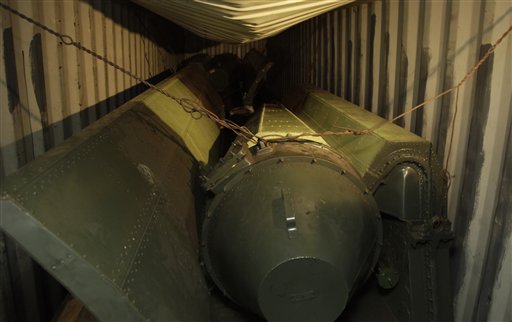By JUAN ZAMORANO and MICHAEL WEISSENSTEIN
Associated Press
PANAMA CITY
A North Korean ship carrying weapons system parts buried under sacks of sugar was seized as it tried to cross the Panama Canal on its way from Cuba to its home country, which is barred by United Nations sanctions from importing sophisticated weapons or missiles, Panamanian officials said Tuesday.
A private defense analysis firm that examined a photograph of the find said the ship appeared to be transporting a radar-control system for a Soviet-era surface-to-air missile system, and Cuba later called the equipment on the boat “obsolete defensive weapons” from the mid-20th century.
A statement from Cuba’s Foreign Ministry late Tuesday acknowledged that the military equipment belonged to the Caribbean nation, but said it had been shipped out to be repaired and returned to the island.
It said the 240 metric tons of weaponry consisted of two Volga and Pechora anti-aircraft missile systems, nine missiles “in parts and spares,” two Mig-21 Bis and 15 engines for those airplanes.
It concluded by saying that Havana remains “unwavering” in its commitment to international law, peace and nuclear disarmament.
Earlier, Panamanian President Ricardo Martinelli said the ship identified as the 14,000-ton Chong Chon Gang was carrying missiles and other arms “hidden in containers underneath the cargo of sugar.”
Martinelli tweeted a photo showing a green tube that appears to be a horizontal antenna for the SNR-75 “Fan Song” radar, which used to guide missiles fired by the SA-2 air-defense system found in former Warsaw Pact and Soviet-allied nations, said Neil Ashdown, an analyst for IHS Jane’s Intelligence.
Panamanian authorities said one container buried under sugar sacks contained radar equipment that appears to be designed for use with air-to-air or surface-to-air missiles, said Belsio Gonzalez, director of Panama’s National Aeronautics and Ocean Administration. An Associated Press journalist who gained access to the rusting ship saw green shipping containers that had been covered by hundreds, perhaps thousands, of white sacks marked “Cuban Raw Sugar.”
The U.N. Security Council has imposed four rounds of increasingly tougher sanctions against North Korea since its first nuclear test on Oct. 9, 2006.
Under current sanctions, all U.N. member states are prohibited from directly or indirectly supplying, selling or transferring all arms, missiles or missile systems and the equipment and technology to make them to North Korea, with the exception of small arms and light weapons.
The most recent resolution, approved in March after Pyongyang’s latest nuclear test, authorizes all countries to inspect cargo in or transiting through their territory that originated in North Korea, or is destined to North Korea if a state has credible information the cargo could violate Security Council resolutions.
Panamanian authorities believe the ship was returning from Havana on its way to North Korea, Panamanian Public Security Minister Jose Raul Mulino told The Associated Press. Based on unspecified intelligence, authorities suspected it could be carrying contraband and tried to communicate with the crew, who didn’t respond. Martinelli said Panama originally suspected drugs could be aboard.
The 35 North Koreans on the boat were arrested after resisting police efforts to intercept the ship in Panamanian waters on Thursday as it moved toward the canal and take it to the Caribbean port of Manzanillo, Martinelli told private RPC radio station. The captain had a heart attack and also tried to commit suicide during the operation, Martinelli said.
Panamanian officials were finally able to board the ship to begin searching it Monday, pulling out hundreds of sacks of sugar.
Luis Eduardo Camacho, a spokesman for Martinelli, said authorities had only searched one of the ship’s five container sections, and the inspection of all the cargo will take at least a week. Panama has requested help from United Nations inspectors, along with Colombia and the UK, said Javier Carballo, the country’s top narcotics prosecutor.
North Korea’s government made no public comment on the case.
In early July, a top North Korean general, Kim Kyok Sik, visited Cuba and met with his island counterparts. Cuban Communist Party newspaper Granma said he was also received by President Raul Castro, and the two had an “exchange about the historical ties that unite the two nations and the common will to continue strengthening them.”
The meetings were held behind closed doors, and there has been no detailed account of their discussions.
The Chong Chon Gang has a history of being detained on suspicion of trafficking drugs and ammunition, Griffiths said. Lloyd’s List Intelligence said the 34-year-old ship, which is registered to the Pyongyang-based Chongchongang Shipping Company, “has a long history of detentions for safety deficiencies and other undeclared reasons.”
Satellite tracking records show it left the Pacific Coast of Russia on April 12 with a stated destination of Havana, then crossed the Pacific and the Panama Canal on its way to the Caribbean. It disappeared from satellite tracking until it showed up again on the Caribbean side of the canal, on July 10, Lloyd’s said.
The disappearance from satellite tracking indicates that the crew may have switched off a device that automatically transmits the ship’s location after it moved into the Caribbean, Lloyd’s said.
Mulino, the Panamanian public security minister, said the ship crossed the Panama Canal from the Pacific to the Caribbean last month carrying a cargo of sheet metal that was inspected by Panamanian authorities.
Griffiths said the Chong Chon Gang was stopped in 2010 in the Ukraine and was attacked by pirates 400 miles off the coast of Somalia in 2009.
Griffiths’ institute has also been interested in the ship because of a 2009 stop it made in Tartus _ a Syrian port city hosting a Russian naval base.
____
Follow Michael Weissenstein on Twitter at http://twitter.com/mweissenstein
___
AP writers Arnulfo Franco in Manzanillo, Panama, Malin Rising in Stockholm, Peter Orsi in Havana, and Edith M. Lederer and Ron DePasquale at the United Nations contributed to this report.

COMMENTS
Please let us know if you're having issues with commenting.